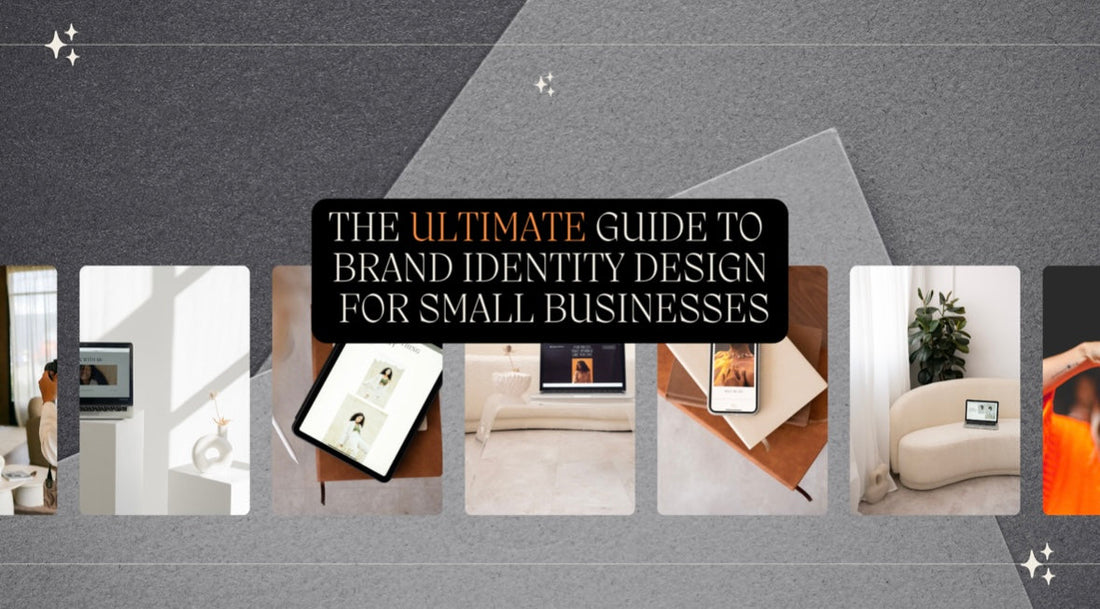Creating a strong brand identity is one of the most critical steps to building a successful business. Your brand identity design goes beyond just a logo—it’s the visual, emotional, and cultural representation of your business. For small businesses, nailing this can set you apart in a crowded marketplace, foster trust with your audience, and connect you deeply with your ideal customers.
In this guide, we’ll break down everything you need to know to create a professional and cohesive brand identity, even if you’re just starting out. Plus, we’ve included actionable steps, real-world examples, expert advice, and free online resources to help you along the way.
What Is Brand Identity Design?
Brand identity design is the collection of visual and tangible elements that shape how your audience perceives your brand. It includes your logo, color palette, typography, imagery, and overall style. Together, these elements work to communicate your brand’s personality, values, and mission.
Think of brand identity as your business’s “first impression.” It’s the face of your business—the one your customers see on your website, packaging, and social media. When done well, it builds trust, creates emotional connections, and leaves a lasting impact.
Quote: “A brand is not just a logo, a website, or a business card. It’s an experience.” — Marty Neumeier, author of The Brand Gap.
Why Is Brand Identity Design Important for Small Businesses?
For small businesses, brand identity design is an investment that pays off in several ways:
First Impressions Matter : Your brand identity is the first thing potential customers notice, whether it’s your social media profile, packaging, or website. A cohesive design builds credibility and attracts attention.
Example : A study by Adobe found that 38% of users will stop engaging with content if the layout or visuals are unattractive.Sets You Apart : In competitive industries, a unique and consistent brand identity ensures you stand out from the crowd.
Example : Glossier’s minimalist branding and millennial-pink palette distinguish it in the crowded beauty industry, making it instantly recognizable.Builds Emotional Connections : Customers often choose brands they feel emotionally aligned with. A well-thought-out identity reflects your values and resonates with your audience.
Example : Patagonia’s branding aligns with its environmental mission, creating loyalty among eco-conscious consumers.Drives Consistency : Whether you’re creating an Instagram post or designing product packaging, a clear brand identity ensures all materials look and feel cohesive.
Online Resource : Read Forbes’ article on building brand recognition for actionable insights.
Step-by-Step Guide to Creating Your Brand Identity
1. Define Your Brand Personality and Values
Your brand personality is the human aspect of your brand. It’s how you communicate and behave in the marketplace, and it’s informed by your core values and purpose.
-
Ask Yourself :
What is my business’s mission?
What values drive my business?
How do I want customers to feel when they interact with my brand?
Example : Nike’s personality is bold, empowering, and determined, aligning with its mission to inspire athletes to “just do it.”
Actionable Step : Write down three adjectives that describe your brand (e.g., approachable, bold, eco-friendly) and refer back to them when making decisions about visuals or tone of voice.
Online Resource : Use the Brand Archetypes Test to identify your brand personality.
2. Research Your Target Audience
Your target audience determines how your brand identity should look and feel. The better you know your audience, the easier it is to design a brand they’ll love.
-
Consider :
Age, gender, and location.
Their values and lifestyle.
The problems they want your product or service to solve.
Example : Starbucks targets an urban, diverse, and socially conscious demographic. Its branding reflects this through clean typography and warm, earthy tones.
Actionable Step : Create a customer persona. Answer these questions: Who is your ideal customer? What do they value? Where do they spend their time online?
Online Resource : Use Google’s free Market Finder Tool to understand your audience better.
3. Develop the Core Visual Elements
Here are the essential components of a brand identity:
Logo : Your logo is the centerpiece of your brand identity. It should be simple, memorable, and versatile.
Example : Apple’s logo is a prime example of simplicity and recognition. Its sleek, minimalist design reflects innovation and quality.
Online Resource : Use tools like Looka or Canva for DIY logo design.Color Palette : Choose 3-5 colors that reflect your brand’s personality. Use color psychology to guide your choices.
Example : McDonald’s uses red and yellow to evoke excitement and happiness, perfect for a fast-food chain.
Online Resource : Use Coolors.co to generate color palettes.Typography : Select 1-2 fonts for your branding. Typography should align with your brand’s personality.
Example : The New York Times uses classic serif fonts to convey authority and tradition.
Online Resource : Explore fonts on Google Fonts .Imagery Style : Define the type of photos, illustrations, or graphics you’ll use.
Example : Airbnb uses user-generated content in its visuals to highlight community and belonging.
Actionable Step : Create a Pinterest board with logos, colors, and typography that inspire you. Use this as a reference when creating your brand.
4. Create a Brand Style Guide
A brand style guide ensures consistency across all platforms. It’s especially useful if you work with designers, marketers, or freelancers.
-
What to Include :
Logo variations.
Exact color codes (HEX, RGB, CMYK).
Typography guidelines.
Imagery do’s and don’ts.
Example : Netflix’s style guide includes details on logo placement, color usage, and font choices to maintain a consistent identity.
Online Resource : Check out 99designs’ Brand Style Guide Examples for inspiration.
Actionable Step : Use Canva’s Brand Kit Tool to organize your assets in one place.
5. Ensure Consistency Across Platforms
Consistency builds trust. Your brand should look and feel the same everywhere—your website, social media, packaging, and ads.
Example : Coca-Cola’s branding is so consistent that its iconic red-and-white color scheme is recognizable without text.
Actionable Step : Audit your online presence. Check if your website, social media, and print materials use the same colors, fonts, and tone.
Online Resource : Use Hootsuite to schedule and manage branded social media content.
6. Test and Refine
Once your brand identity is live, gather feedback. Does it resonate with your audience? Is it achieving the desired emotional impact?
Example : Mailchimp rebranded in 2018 with bold illustrations and quirky typography. It tested the rebrand extensively before launch to ensure it would connect with its target audience.
Actionable Step : Use Google Forms to create a feedback survey asking customers how they perceive your branding.
Online Resource : Learn about customer feedback tools on Sprout Social .
Expert Tips for Small Businesses
-
Paul Rand, legendary designer : “Design is the silent ambassador of your brand.”
Invest in design. It’s the first thing customers notice about your brand.
-
Seth Godin, marketing guru : “People do not buy goods and services. They buy relations, stories, and magic.”
Your brand identity should tell a story that resonates emotionally with your audience.
Final Thoughts
A strong brand identity design is a powerful tool for small businesses. It builds trust, sets you apart, and ensures your brand is memorable. By following this guide and leveraging the tools and resources shared, you’ll be well on your way to creating a cohesive and impactful brand identity that drives growth.
What’s next? Use the resources and actionable steps above to start crafting your brand identity today. Have questions or need inspiration? Let us know in the comments!



